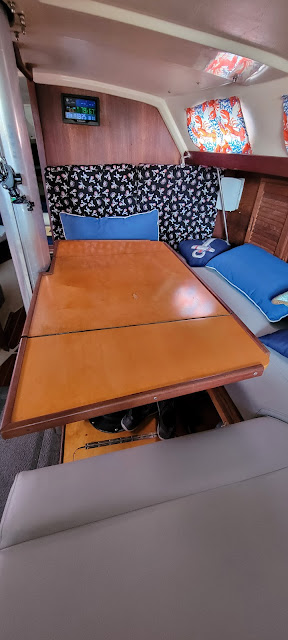New DIY Cabin Table
 |
| Before |
 |
| After |
 |
| Another Project completed. |
Our sailing experience on a 1987 Catalina 34 which we named 'Eximius' which google showed as the Latin translation for 'Special' We hope that our posts will help others looking to take their boat beyond the local waters as well as provide entertaining reading. I'm a Brit, so my view of entertaining may not match yours ;) See you on the water. The Journey Starts Here Paul
 |
| Before |
 |
| After |
 |
| Another Project completed. |
| Overview of the Orion Charger |

 |
| The Gray arm is the original |
 |
| The Original is laying on top of the new arm |
 |
| L-to-R Original, Primed, Finished |
Our existing External Regulator is a backup unit from when the Zantrex Power Management System was installed, now replaced with our Victron Power Management System. The old external regulator does not have the features to protect our Balmar 6 series 100A Alternator nor does it consider the battery temperature nor the Battery Voltage. The Balmar MAX MC-618 does ( The H indicated that it is supplied with an electrical harness.)
I purchased the regulator from PKYS online and was surprised that it's cost was competitive with Amazon and it's delivery was at least as good, it arrived early. When it arrived, I thought I had the wrong item. I sent an email to PKYS explaining that they had sent the wrong item.
But!!! As you can see from the picture above, it's identified as a MAX Charge MC-618 not as an MC-618-H, I found that the label on the underside of the regulator shows it's a MC-618-H I and sent a follow up email to PKYS apologizing for my mistake.
I read through the manual again and realized that I didn't order the two Temperature Sensors, Duh! I placed another order for them. After placing the order, I called PKYS just to make sure they didn't react to my first email regarding the wrong item. They actually picked up the phone and responded to my query. Very helpful. The order for the two temp sensors arrived a day earlier than expected ( ordered Monday arrived Wednesday )
As I mentioned, I read the manual. It's online but I downloaded it and stored it in my 'Manuals' folder for future use. I'm going to print it to keep on board with my other manuals, just in case I'm ever out at sea and no net connection.
Ok, Onto the Installation.
My plan is to keep the existing dumb regulator as a backup, it works, just not very efficiently.
Here's the rough process:
Turns out it was the Drive belt lose again! I went to Broward Bolt and got a few of these Nord-Lock washers used to keep Turbo Units on cars & trucks from shaking lose.
I need to adjust the belt tension and lock the bolts in place with these washers.
FYI, I make a point of going to Broward Bolt as soon as I need any type of bolt, nut or washer!
1560 N Powerline Rd, Pompano Beach, FL 33069
The staff are awesome, they have never been out of stock for anything that I needed and have always been really helpful. Must admit, when I first went there a few years ago, I was expecting they would be expensive but happily surprised that their prices are very reasonable. They are not sponsoring me at all, I just feel the need to promote really good customer service. Give them a call next time you need Nuts, Bolts or Washers ( and drill bits, hole saws and two part epoxy mixes - the type in Tubes like Caulk ) (954) 960-1740
Here's the wiring diagram for this project.
OK, we're headed down to the boat in the morning, I'll try to take a bunch of pics of the install and Alternator Tensioning.